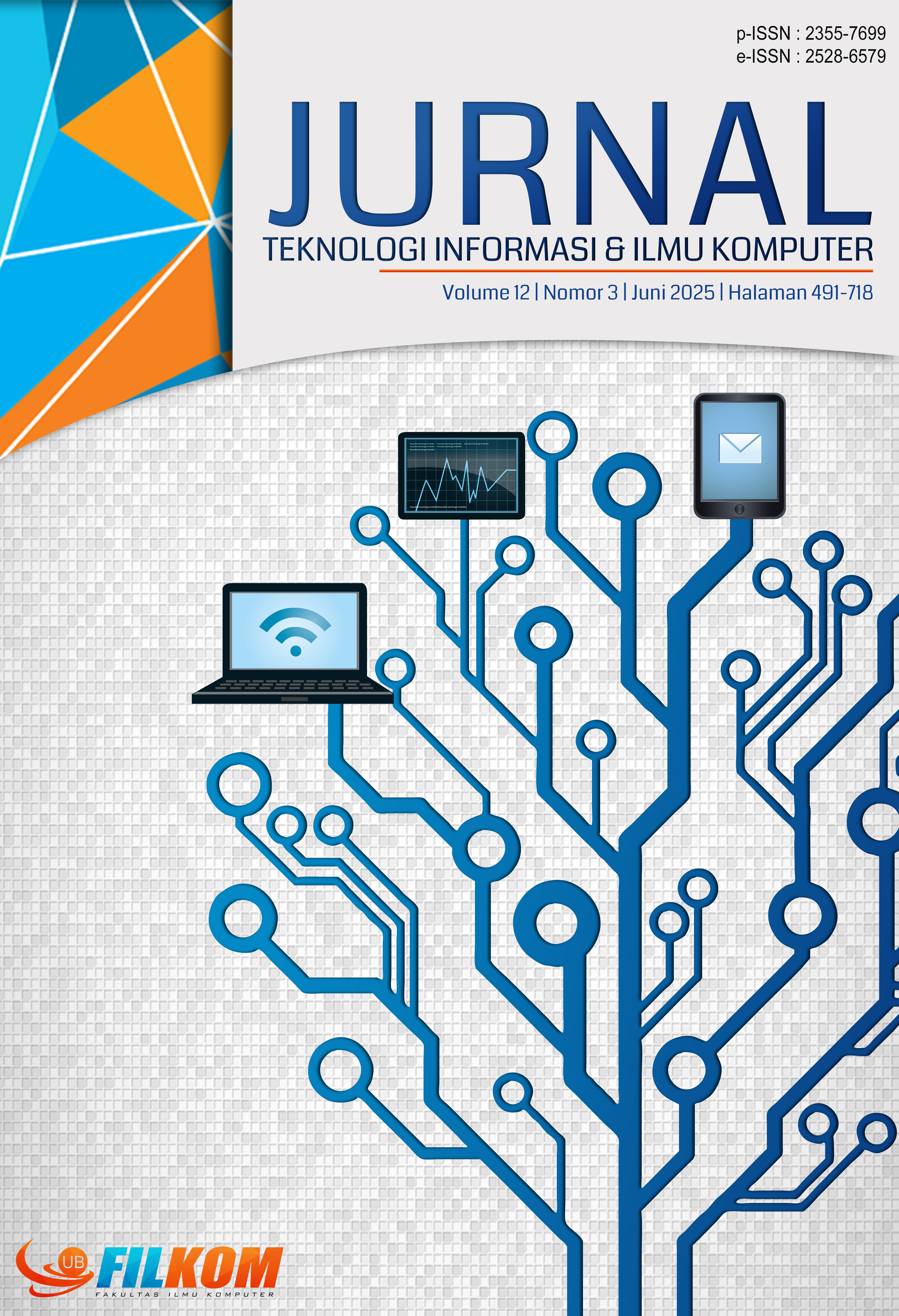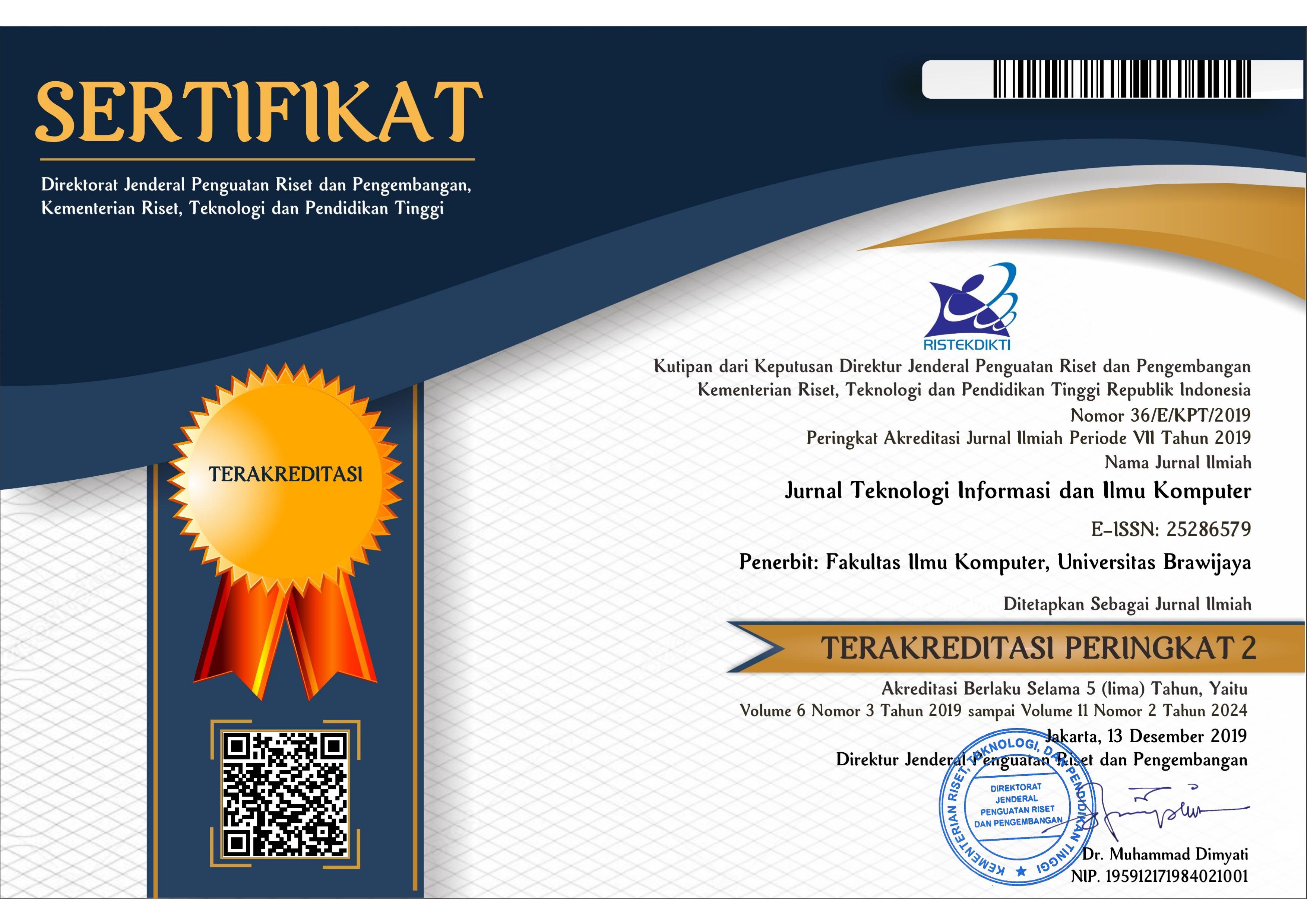Pengaruh Non-Automatic Repeat Request (Arq) Mode Terhadap Packet Error Rate Pada Drone-Based Wireless Sensor Network
DOI:
https://doi.org/10.25126/jtiik.2025129373Kata Kunci:
Wireless sensor network, Drone, Zigbee 2.4 GHz, non-ARQ mode, point-to-point communicationAbstrak
Penelitian ini membahas tentang performa dari 2.4 GHz Zigbee wireless antenna untuk aplikasi wide-area wireless sensor network. Transmitter antenna di install pada drone sebagai media mobile wireless sensor network dan receiver antenna berada di lokasi tertentu pada lingkungan luar ruangan. Setingan alat untuk transmitter antenna dan receiver antenna yaitu non-Automatic Repeat Request (ARQ) mode sehingga data yang di terima oleh receiver dalam experimen ini nanti bisa menjadi perbandingan dengan hasil perhitungan teoritis menggunakan Matlab. Non-ARQ menjadi alternative untuk mengurangi konsumsi energi pada jaringan wireless sensor network. Dalam experimen ini dilakukan model point-to-point communication. Dari hasil experimen diperoleh jarak 0m-100m nilai dari Packet Error Rate (PER) untuk masing-masing ketinggian drone meningkat mencapai 17-18%. Lebih lanjut pada jarak 100m-150m nilai PER mengalami penurunan yaitu 15-16% untuk tiga ketinggian drone yang berbeda. Mulai dari jarak 150m-250m nilai PER mengalami kenaikan yang siginifikan, hingga mencapai PER 70% untuk ketinggian drone 30m, PER 80% untuk ketinggian drone 45m dan PER 88% untuk ketinggian drone 15m. Pada jarak 250m-350m nilai PER terlihat masih konstan untuk ketinggian drone 45m dan ketinggian 30m yaitu mencapai nilai PER 78% pada jarak 350m, sedangkan untuk ketinggian drone 15m menunjukan nilai PER naik hingga mencapai 98% pada jarak 350m. Hasil simulasi dengan Matlab menunjukan Received Signal Strength Indicator (RSSI) terhadap jarak transmitter antenna dengan receiver antenna untuk ketinggian transmitter antenna 15m dan receiver antenna 1.5m. nilai RSSI terus meningkat -66 dBm pada jarak 20m dan ini adalah nilai RSSI terbaik. Lebih lanjut untuk ketinggian transmitter antenna 30m dan receiver antenna 1.5m. Nilai RSSI terus meningkat -73 dBm pada jarak 45m dan ini adalah nilai RSSI terbaik. Pada jarak 3m nilai RSSI terus meningkat -76 dBm pada jarak 62m dan ini adalah nilai RSSI terbaik.
Abstract
This research discusses the performance of the 2.4 GHz Zigbee wireless antenna for wide-area wireless sensor network applications. The transmitter antenna is installed on the drone as a mobile wireless sensor network medium and the receiver antenna is located in a certain location in the outdoor environment. The device settings for the transmitter antenna and receiver antenna are non-Automatic Repeat Request (ARQ) mode so that the data received by the receiver in this experiment can later be compared with the results of theoretical calculations using Matlab. Non-ARQ is an alternative to reduce energy consumption in wireless sensor networks. In this experiment, a point-to-point communication model was carried out. From the experimental results, it was found that at a distance of 0m-100m, the Packet Error Rate (PER) value for each drone height increased by 17-18%. Furthermore, at a distance of 100m-150m, the PER value experienced a slight decrease, namely 15-16% for three different drone heights. Starting from a distance of 150m-250m, the PER value experiences a significant increase, reaching a PER of 70% for a drone height of 30m, a PER of 80% for a drone height of 45m and a PER of 88% for a drone height of 15m. At a distance of 250m-350m, the PER value appears to remain constant for a drone height of 45m and a height of 30m, namely reaching a PER value of 78% at a distance of 350m, while for a drone height of 15m, the PER value increases to reach 98% at a distance of 350m. The simulation results with Matlab show Received Signal Strength Indicator (RSSI) to the distance between the transmitter antenna and the receiver antenna for a transmitter antenna height of 15m and receiver antenna height of 1.5m. The RSSI value continues to increase -66 dBm at a distance of 20m and this is the best RSSI value. Furthermore, the height of the transmitter antenna is 30m and the receiver antenna is 1.5m. The RSSI value continues to increase -73 dBm at a distance of 45m and this is the best RSSI value. At a distance of 3m the RSSI value continues to increase -76 dBm at a distance of 62m and this is the best RSSI value.
Downloads
Referensi
GHARGHAN S. K, R. NORDIN, M. ISMAIL AND J. A. ALI. 2016. Accurate Wireless Sensor Localization Technique Based on Hybrid PSO-ANN Algorithm for Indoor and Outdoor Track Cycling in IEEE Sensors Journal, vol. 16, no. 2, pp. 529-541, Jan.15, 2016.
GANEV Z. 2020. Ovrview and comparison of some outdoor radio propagation models in Wireless Sensor Networks in 2020 International Conference Automatics and Informatics (ICAI), Varna, Bulgaria, 2020, pp. 1-6.
LUO J, Z. ZHANG, C. LIU AND H. LUO. 2018. Reliable and Cooperative Target Tracking Based on WSN and WiFi in Indoor Wireless Networks in IEEE Access, vol. 6, pp. 24846-24855, 2018.
BRISO C, C. CALVO AND Y. XU. 2019. UWB Propagation Measurements and Modelling in Large Indoor Environments in IEEE Access, vol. 7, pp. 41913-41920, 2019.
GARCÍA-REQUEJO A, M. CARMEN PÉREZ-RUBIO, J. M. VILLADANGOS AND Á. HERNÁNDEZ. 2023. Activity Monitoring and Location Sensory System for People with Mild Cognitive Impairments in IEEE Sensors Journal.
RAHMADYA B, Z. ZAINI, M. MUMUH. 2020. IoT: A Mobile Application and Multi-hop Communication in Wireless Sensor Network for Water Monitoring in International Journal of Interactive Mobile Technologies (iJIM), vol.14, no.11, pp. 288-296, 2020.
HUY. X. P., HUNG. M. L., DAVID F. S., LUAN. V. N. 2018. Autonomous UAV Navigation Using Reinforcement Learning.
YO, P. H, LUCKY, S., & TSU, T. L. 2019. Structure From Motion Technique for Scene Detection Using Autonomous Drone Navigation. IEEE Transactions on Systems, Man, and Cybernetics: Systems.
MOHAMMAD, M., WALID, S., MEHDI, B., & MEROUANE, D. 2017. Performance Optimization for UAV-Enabled Wireless Communications under Flight Time Constraints.
SIXING, Y., YIFEI, Z., & LIHUA, L. 2016. UAV-assisted Cooperative Communications with Time-sharing SWIPT.
NIEL, A. C., REZA, M., & LAKSHMI N. 2016. Design of Smart Sensors for Real-Time Water Quality Monitoring. IEEE Access August 26, 2016.
BRIAN. R. G., ANTONIO. R. S., TYLER. M. B., ELIZABETH. A. P. L., & PHILLIP. B. C. 2019. Environmental and Sensor Integration Influences on Temperature Measurements by Rotary-Wing Unmanned Aircraft Systems. Sensors. Published: 26 March 2019.
ALOK. M. J., & Neeraj. T. 2015. An implementation of Automatic Repeat reQuest (ARQ) mechanism in cooperative wireless networks using max-ratio relay selection. International Conference on Innovations in Information, Embedded and Communication Systems (ICIIECS), Coimbatore, India, 2015, pp. 1-5.
RAHMADYA. B., MASAHIRO. U., XIAOYAN. W., & SHIGEKI. T. 2020. On Link Performance According to Flight Route in Drone-Based Wide Area Wireless Sensor Networks," 2020 International Conference on Space-Air-Ground Computing (SAGC), Beijing, China, 2020, pp. 49-53.
Unduhan
Diterbitkan
Terbitan
Bagian
Lisensi
Hak Cipta (c) 2025 Jurnal Teknologi Informasi dan Ilmu Komputer

Artikel ini berlisensiCreative Commons Attribution-ShareAlike 4.0 International License.

Artikel ini berlisensi Creative Common Attribution-ShareAlike 4.0 International (CC BY-SA 4.0)
Penulis yang menerbitkan di jurnal ini menyetujui ketentuan berikut:
- Penulis menyimpan hak cipta dan memberikan jurnal hak penerbitan pertama naskah secara simultan dengan lisensi di bawah Creative Common Attribution-ShareAlike 4.0 International (CC BY-SA 4.0) yang mengizinkan orang lain untuk berbagi pekerjaan dengan sebuah pernyataan kepenulisan pekerjaan dan penerbitan awal di jurnal ini.
- Penulis bisa memasukkan ke dalam penyusunan kontraktual tambahan terpisah untuk distribusi non ekslusif versi kaya terbitan jurnal (contoh: mempostingnya ke repositori institusional atau menerbitkannya dalam sebuah buku), dengan pengakuan penerbitan awalnya di jurnal ini.
- Penulis diizinkan dan didorong untuk mem-posting karya mereka online (contoh: di repositori institusional atau di website mereka) sebelum dan selama proses penyerahan, karena dapat mengarahkan ke pertukaran produktif, seperti halnya sitiran yang lebih awal dan lebih hebat dari karya yang diterbitkan. (Lihat Efek Akses Terbuka).








